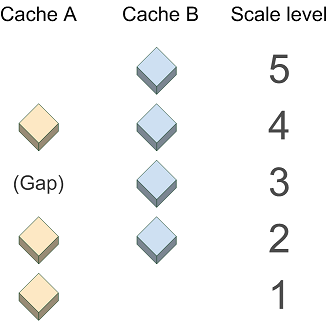When you create any cache that will be used with an ArcGIS Data Appliance cache in the Java Web ADF, the following items are important to note:
The map caches on the ArcGIS Data Appliance use the WGS_1984_Web_Mercator coordinate system, and your cached map must also use this coordinate system in order to achieve a successful overlay.
To set the coordinate system of your map to WGS_1984_Web_Mercator:
All of the data in your map will be projected on the fly to this coordinate system. When you cache the map, it will be cached in this coordinate system.
The tile origin represents the upper left corner of the geographic extent covered by the cache tiles. When building any cache that will be viewed through the Java Web ADF, you should avoid placing the tile origin at any point inside the Full Extent of the map. Placing the tile origin on the upper left corner of the Full Extent is appropriate.
For example, many of the ArcGIS Data Appliance maps have worldwide coverage. Since the upper-left corner of the Full Extent on a 2D surface is -180, 90, this point was used for the tile origin when the cache was generated.
When entering the parameters for the map cache, avoid changing the tile origin that appears by default. This value is retrieved automatically from the upper-left corner of the full extent of the map document. If you want to change the tile origin, the recommended workflow is to do the following:
When overlaying caches in the Java Web ADF, the tile origins of the caches are not required to match. The tile sizes can also differ between caches.
When you add any cached service to your map, your map becomes visible only at the scale levels of that cached service. When you add two or more cached services to your map, the map becomes visible at all of scale levels in all of the cached services; however, the caches will only overlay at the scale levels they have in common.
To provide a smooth navigation experience for the users of your Web applications, ensure that the scale levels in your caches match whenever possible. Failure to sequentially match the scales of the caches could result in layers not being visible at expected scales. For example, in the diagram below, Cache A was not created at scale level 3, therefore when the user zooms to Scale 3, only Cache B will be visible. Similarly, at scale level 5 Cache A will not be available, but since it is common behavior for a layer to become unavailable at a minimum or maximum scale, this may not present the same problem as the gap at scale level 3.

Many of the caches on the ArcGIS Data Appliance have worldwide coverage at a large variety of scales. You do not need to create your cache using all of these scales, but, where possible, the scale levels you use should match the ones used in the ArcGIS Data Appliance caches.
Following is a list of the scales used on the ArcGIS Data Appliance. Each cache uses all of these scales or a sequential subset of them. (The high-precision values of the scales are necessary for the caches with worldwide coverage to appear seamless at 0 degrees longitude.) When building any cache that will overlay a cache from the Appliance, you should match the values exactly in order to see both caches. For instructions on how to create a map cache that uses these scales, see the Create a Map Cache section in Designing a map to overlay Google Maps or Microsoft Virtual Earth in the ArcGIS Server Java Help.
The basemap caches on the ArcGIS Data Appliance use the JPG image format, while the reference caches use 8-bit PNGs. (You can use the Directory of Services to learn which caches are considered basemaps and which are reference.) Although the JPG format displays faster than other formats, it does not support transparency. Therefore, any basemap caches on the appliance will obscure layers that are placed beneath them. Similarly, if you create your own JPG cache, you will not be able to see any layers you place beneath it.
Back to ArcGIS Server User Guide